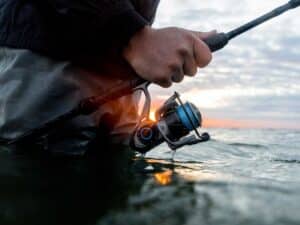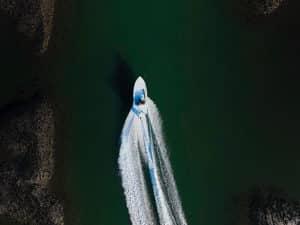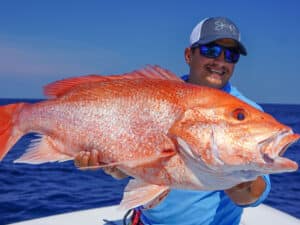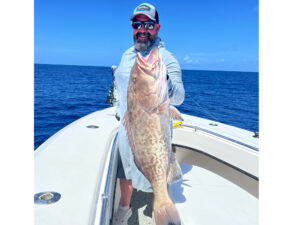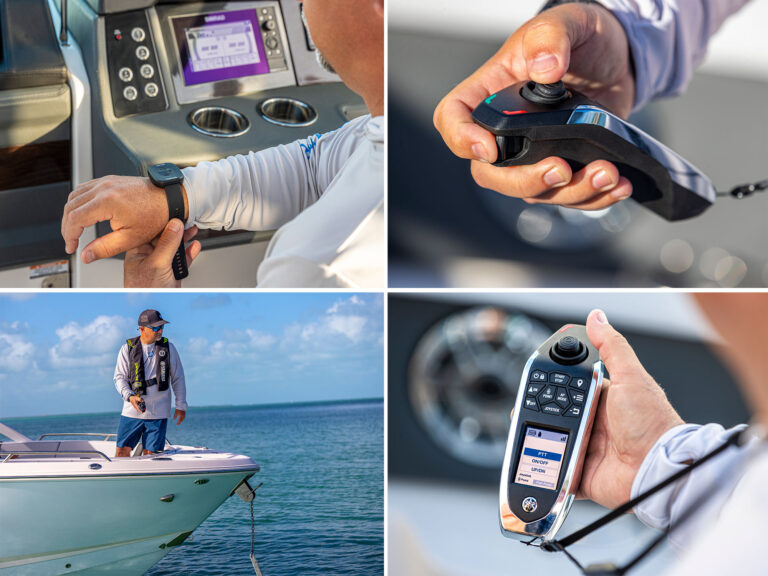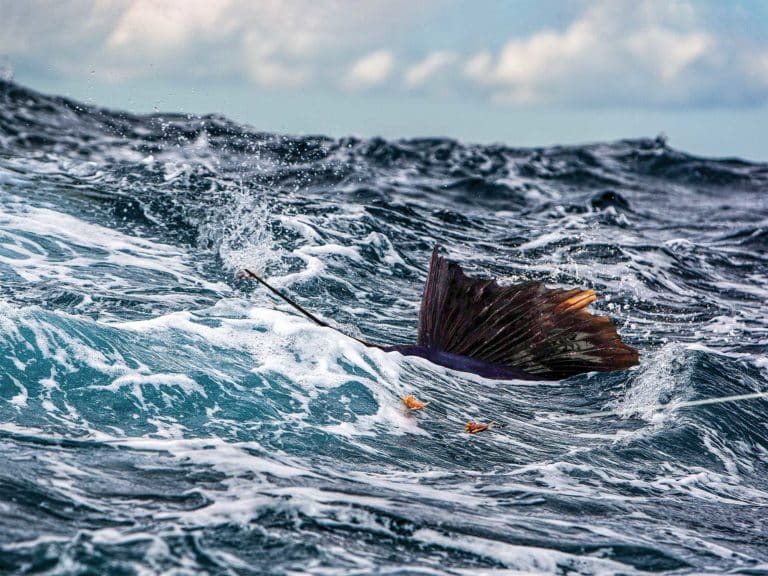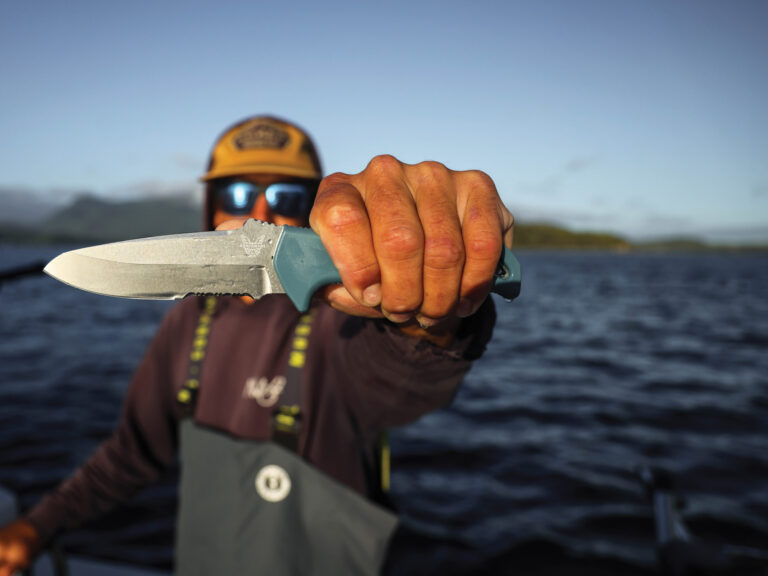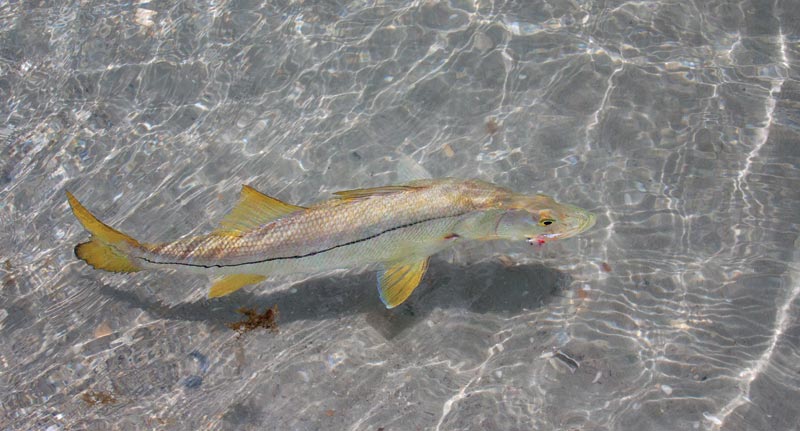
The thought of fishing from the beach for snook conjures up images of crystal-blue water, gentle breezes, bright sunshine and plenty of fish meandering up and down the shoreline. While days like this appear picturesque and ideal, fly fishing for snook only during these perfect-condition windows leaves anglers with an abundance of missed opportunities.
For those who, like me, live close to the beach, it’s easy to become spoiled. But it never ceases to amaze me when I hear that a Midwestern tourist landed a trophy snook from the beach on a day I deemed unfishable. The point is, during the summer in Florida, snook can be found along the beaches on any given day, but you’ve got to know how to adapt to what Mother Nature throws at you.

Looking for Love
From April through late October, snook move from the backcountry to the beaches with one thing on their minds: making little snook. They change habits, personality and appearance. A typical adult snook will spawn two or three times per week during the summer. As with other species, the largest fish are females. The odd thing about snook is that most fish are born male and, at about 24 inches in length, change sex and become female.
While snook can be very spooky and at times noncooperative, a thoughtful presentation can coerce an eat. The first order of business is spotting the fish. Early in the summer, when the fish show up on the beach from the backcountry, they are dark, which makes them easy to see. However, as the summer progresses, the fish change to a silvery color, which makes them extremely difficult to spot. When the sun is high and extra bright, forgo looking for an actual fish and focus on looking for shadows on the sandy bottom. Visitors are always shocked to find snook inches from dry sand. Norm Zeigler, author of Snook on a Fly, says that, when sight-fishing, if you are wet above the ankles, you are wading too deep. Keep the fly in hand, and keep your false casts to a minimum to prevent spooking the fish. When possible, fish into the sun to keep your presence subdued.

Once you spot a target, resist the temptation to immediately fire off a cast. Instead, take your time. Snook spend their time on the beach cruising up and down and rarely dart around or swim erratically. Determine the direction that your fish is traveling, and don’t take your eyes off of it.
Baitfish never swim to the mouth of a predator, so make your presentation so your fly swims away from your target when stripped. This inevitably will require moving well ahead of the fish, making a cast and waiting until the fish gets close to the fly before you strip it.
When there is mild wave activity, you may see the fish only between waves, which necessitates a little guesswork. What you lose in visibility, you gain in ease of presentation, though. In this situation, fish seem to be a little more at ease and lose their spooky attitude. In addition, the slight wave action gives your fly a little extra motion.
When you do catch sight of a beach snook, you’ll typically see one or two together, often moving slowly and steadily, or occasionally not at all. At times, schools of up to 50 fish magically appear, and when they do, always target the lead fish, just as you would with a string of tarpon.
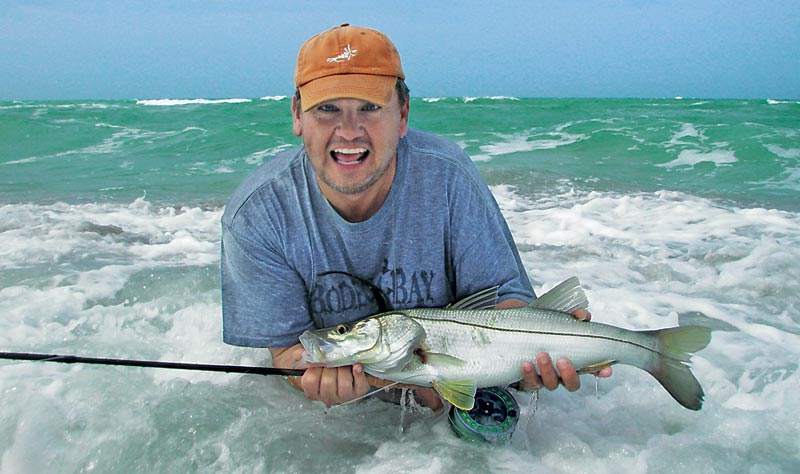
Ebb and Flow
Tidal movement makes up a major piece of the beach snook-fishing puzzle. Any kind of moving water makes snook happy, but an incoming tide is generally preferred. The middle of the tide cycle has the most water movement and the most available bait, which is what you want. For example, with a 6 a.m. low tide and a noon high tide, 9 a.m. should be prime time. I find there is a 30-minute window in the middle of the tide when the fish become particularly aggressive. The best sight-fishing happens when the middle of the tide cycle occurs during the brightest part of the day.
During slack tide periods, even though you may see fish, it can be difficult to draw a strike.
On the beach, baitfish are commonly easier to spot than the snook themselves. Find the bait schools, the tighter the better, and look around the edges. Often you will see a “bald spot” in the middle of the bait pod. Closer examination regularly reveals a snook lying in the midst of the bait, with the wary baitfish giving it plenty of room. The most exciting fishing comes when schooling snook round up bait into a very tight ball and attack at once. Obviously, busting fish stick out like a sore thumb, and placing your fly in the middle of the action will almost always result in a hookup.
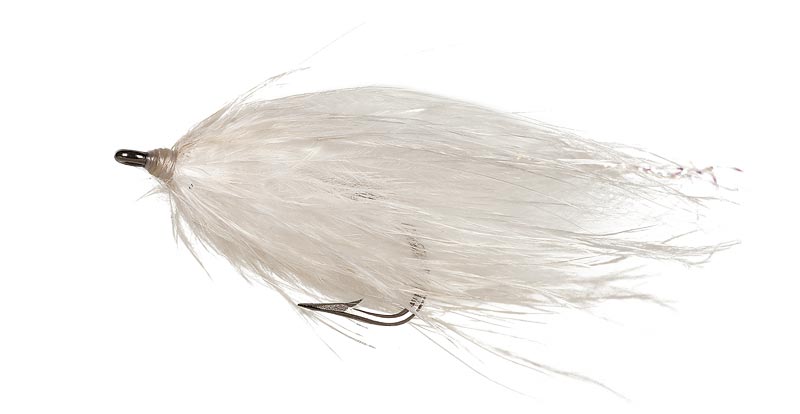
Surf’s Up!
In very short order, that glassy beach can swell and send all but the heartiest anglers packing. Trout fishermen adapt well in these conditions by putting their water-reading skills to work. For the most part, when the water is rough and cloudy, anglers should switch to a blind-casting strategy.
When choosing a stretch of beach for blind-casting, look for the same characteristics that you would with any other type of fishing. A straight, shallow beach doesn’t do much for me. However, when I find a stretch that has points, bars and drop-offs, I get real excited. How steeply the beach rises out of the water will give you a good indication of how things look underwater, and any change in bottom or current is worth a few casts. I never pass up what I call a beach boulder, a small channel in the sand formed by water running off the beach. When the returning water collides with the surf, a chocolate-colored ball of moving sand and tiny shells materializes. Approach the beach boulder just like a boulder in a stream. Make a curve cast around the backside of the boulder, and work your baitfish pattern as you would dead-drift a Nymph, letting the surf impart the action rather than stripping.
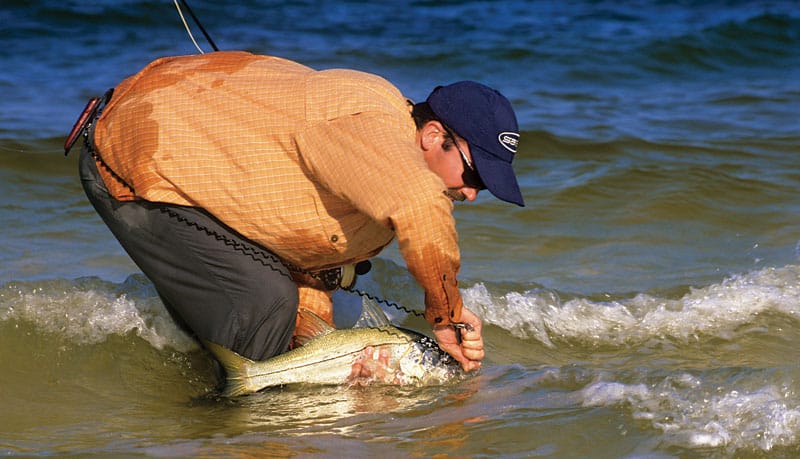
Troughs are another key feature. Usually there are two, one just off the beach and one farther out. A trough forms where the waves break and most often range from one to three feet in depth. Snook and other fish use troughs as combination superhighways and buffet lines. If you’re standing at the water’s edge and see a snook sitting in the trough uncomfortably close, slowly move away from the fish and make your cast from farther away.
When the beach is dotted with shell hunters and sunbathers, you can still see snook, but in general, a crowd makes the fish very uncomfortable and fly-casting difficult. This scenario eventually becomes unavoidable, but you can move to fish either the first trough from the outside or the second trough. Heavier surf breaking on the beach will push the fish out slightly. I like to wade to the breaker line and cast on the backside, keeping my fly in the swell by repeatedly mending my line over the wave, giving a to-and-fro motion to the fly.
One of my best days came in early May of last year, when I was fishing with my friend Max Galmez. The surf was very rough but still blue in color, and we had the beach to ourselves. At one point I looked over to see only Galmez’s arm and bent rod sticking above the foamy surf. In two hours’ time, we landed 17 snook from 24 to 30 inches, proving that persistence pays and snook aren’t always in close.
Choosing the Right Fly
Fly selection is not nearly as important as presentation — as long as the pattern meets a few criteria. I carry white or silver flies on the beach. A good glass minnow pattern, such as
Johnson’s Petticoat Streamer, Gibby’s DT Special or Norm’s Crystal Schminnow, is all you need.
For sight-fishing, the Schminnow is hard to beat. I like it because it suspends nicely in the water column and allows me to wait on my fish. Gibby’s DT Special works well for blind-casting in calmer waters and low-light conditions. I believe the bit of red on the collar gets a little more attention. I refer to the Petticoat Streamer as a Snook Nymph. Made mostly of marabou, this fly does its finest work when left stationary in the water column.
Many anglers have great success with weighted flies, such as Clouser Minnows, but when sight-fishing, I find that the splash of the fly usually sends the snook on its way. A good look at snook’s eye position and slight underbite reveals that they are designed to feed primarily from below their prey. Certainly they will eat shrimp and crabs off the bottom, but in general, snook look up for most of their meals.
The right fly will not work without the right action, but anglers commonly make a nice cast to a fish and strip way too fast. Instead, anglers should strip long and slow. Make your slowest strip, and then strip half that fast. Many times I have been talking to someone on the beach or getting a drink of water, and wham! What was I doing right? I was doing nothing at all. Another strip that works well is the “shrimp strip,” that being two or three quick micro-tugs followed by a long pause.
A Fight to the Finish
Once the strike occurs, strip-strike with authority for a solid hook-set. After you make the cast, place the rod tip in the water. If the rod tip is left in the air, slack develops immediately, and when you strip, you simply will be moving the slack up and down. If a fish hits while your rod tip is raised, you will have to remove the slack before connecting with the fish. Placing the rod tip in the water keeps your line tight so when the strike does occur, a sharp strip will drive the hook home.
Landing a snook on the beach differs greatly from a backcountry battle. While snook can make good runs, beach fights generally don’t last too long. As with tarpon, “bowing” to an airborne snook keeps it buttoned up.
I believe most lost fish come unglued when they swim toward the angler. When this happens, the natural tendency is to raise the rod tip and reel quickly to eliminate slack. As the reel is cranked, the tip wiggles back and forth — the same motion that you might use to free a snag. A better tactic is to drop the rod tip into the water and then reel. The water resistance keeps tension on the fish until the slack is gone.
When you land your snook, be very careful not to lift the fish by its lower jaw alone, but rather support its underside as well. A long battle can be fatiguing to a large snook, particularly in the summer. Subdue the fish quickly, and never drag it onto the sand. Before you release the fish, make sure it’s strong enough to swim away unaided.
Equipment and Rigging
Rods: A 9-foot 8-weight rod with an appropriate-size reel is the perfect setup for beach snook. Many visitors bring 9- and 10-weights, but a day or so of blind-casting will usually justify the purchase of an 8 before the trip home. You can catch snook on lighter outfits, but picking up and swiftly delivering a No. 2 fly in breezy conditions can be a tall order with lighter equipment.
Lines: A floating line works well in most situations. A line such as a bonefish taper will load the rod quickly and shoot well, allowing for gentle presentations on longer casts. Intermediate lines have their place as well. When you’re sight-fishing and snook are extra spooky, a clear intermediate line provides stealthier presentations and allows the use of a shorter leader. The downside is a slower, more difficult pickup when taking a second shot at a moving fish. Intermediate lines really shine when there is wave action. A floating line will follow the contour of the surface, and every wave will add just that much more slack, while an intermediate line will cut through the wave to give a direct connection to the fly.
Leaders: For me, a simple formula works best, and here it is. For sight-fishing, I prefer a 9-footer that follows the 50 percent, 25 percent, 25 percent formula. The 4½-foot butt is 40-pound-test, the 2¼-foot midsection is 30-pound-test, and the 2¼-foot tippet is 20-pound-test. In addition, a 12-inch bite tippet of 30-pound-test may be added if you expect to encounter larger females, as wear from their rough mouths can substantially weaken the material. I prefer mono for the butt and midsection and fluorocarbon for the tippet and bite tippet. On the terminal end, I use a nonslip loop knot that allows the fly to swing freely.
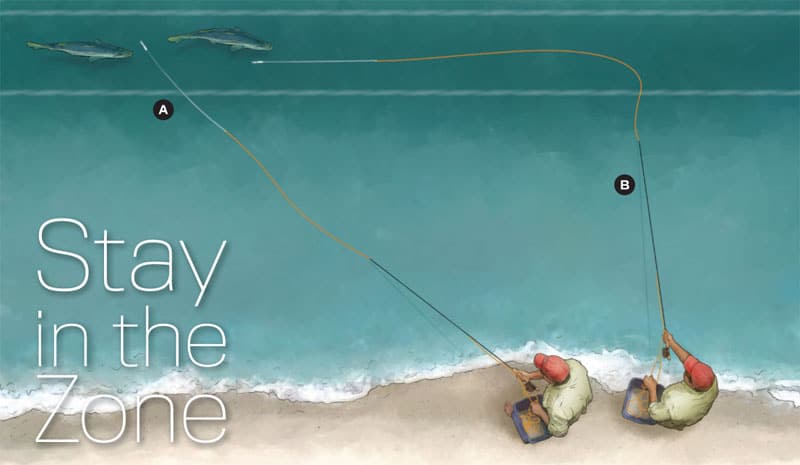
On your next trip to the beach, take the time to observe bait movement in the water. You will notice that bait move back and forth in a zone parallel to shore. The same can be said for snook. A typical cast across this zone is good for only three or four strips (A). And because the fish move parallel to the shore, your fly will be in the zone for only a few strips . The longer you can keep your fly in that zone, the better your chances of drawing a strike. A reach cast or aerial mend will land the fly in front of your target and place the leader and fly line in the zone as well. This will keep the fly in your snook’s path much longer and allow it to move in the same direction and ahead of your snook. To execute this cast, first make an overhead cast at your target, and immediately after the stop on the forward stroke, slip line and gently point your rod tip 90 degrees from the shore (B). After the line falls to the surface, keep your rod tip pointed directly at the line and keep your eyes on the fly. When retrieving, be sure to keep your rod tip in the water or very near it.

